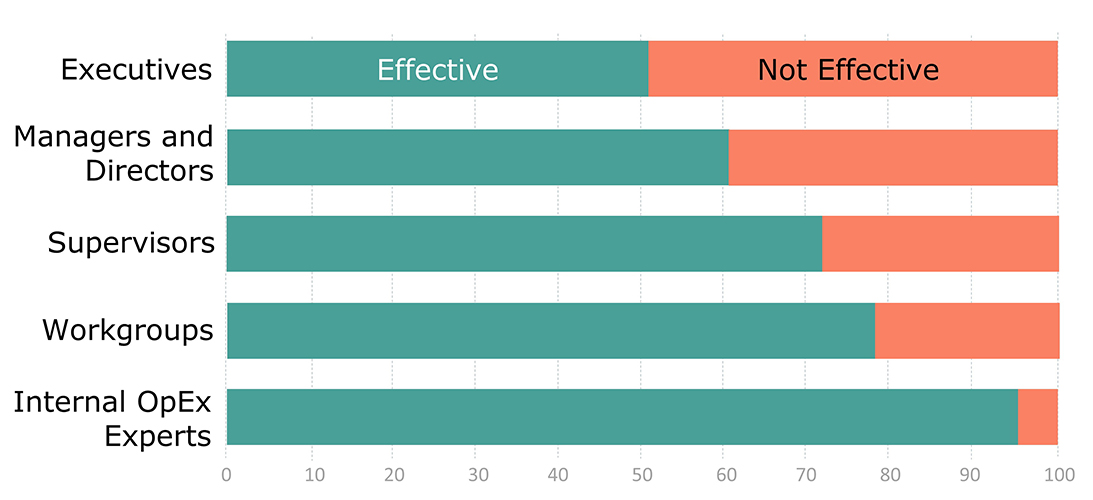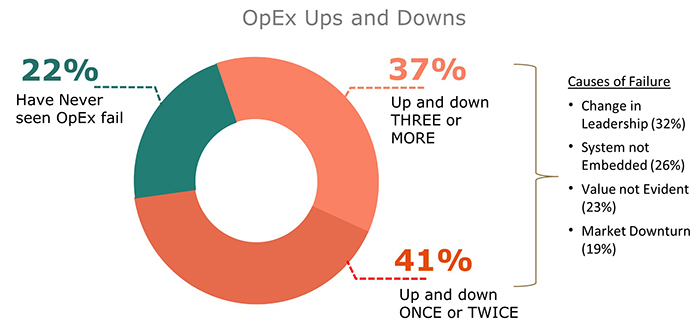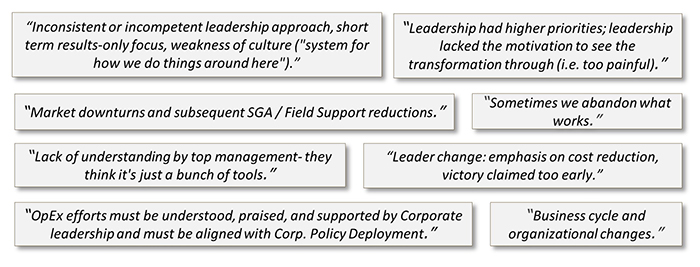Posts
Three OpEx Questions and Answers
/in Engagement, Leadership /by Amy HowardA small group recently posed a few questions to us about Operational Excellence, leadership and change. They were looking to get started on their journey and wanted to understand our perspective on some of the critical elements. Here’s a recap of the ensuing discussion with OpEx questions and answers. If you’ve got some questions about OpEx, send us a note (hit the Contact button and start the discussion there). With a dialogue like this, we all learn something.
—
Q. Leaders mostly understand the benefit of engagement and often see OpEx as a way to obtain this, yet it seems that leaders are not well equipped to make this happen. In fact, the training for leaders is often ineffective. How do we overcome this gap?
A. The graph below is sourced from our YE16 OpEx survey report. It shows how the surveyed organizations ranked the effectiveness of training at various levels of the organization and across a variety of business types:

Img 1 – The relative effectiveness of OpEx and Engagement Training at different levels of the organization. It’s notable that training is deemed most effective at the lowest levels of the organization while executive level training is deemed effective only about 50% of the time.
We can all see the connection between better engagement scores and improved performance, however there is a lot of confusion about what good engagement looks like. Often engagement is thought to be more frequent face time between bosses and subordinates, 360 feedback, suggestion programs, and so on. Rather, good engagement is about giving people the ability to directly influence their work. It recognizes basic human needs that include the power to make decisions, the ability to control outcomes and being part of something bigger. These attributes are not naturally occurring in many work environments so equipping leaders to enable OpEx is about training and coaching them on the essential actions and behaviors they must take to engage and align the organization from top to bottom.
Our approach to ensuring effective leadership training starts with the Managers / Executive Lean Overview workshops. These sessions quickly inform the team with a common vocabulary, awareness and understanding of:
- Lean concepts and the Lean enterprise
- Developing the right culture, structure and behaviors to support Lean
- Managing resistance to uncertainty, and
- Driving measurable results linked to the business strategy and objectives
Tools and methods are covered, but gaining expert capability on them is not specifically intended. Rather, this portion of the workshop is meant to provide context for how front line practitioners apply problem-solving tools to achieve desired business outcomes.
Our primary objective with leaders and managers is to provide insights that help them define and develop their own leader standard work. This means doing the hard work of changing some of their own behaviors and habits to be able to actively coach and demonstrate support for Lean to the organization as implementation begins.
Beyond training and workshops, coaching is an important element that we always employ during project work with clients. Coaching is about observing behaviors and suggesting alternatives that can be more effective at delivering certain results. A simple example: If you want people to be more engaged, ask leading questions as opposed to prescribing a potentially ill-conceived solution. In this way, everyone learns something and engagement is supported instead of stifled.
Q. If the leaders are not equipped to lead engagement, can implementation still be successful if delegated to a lower level?
A. No. We’re talking about a shift here that must be valued up and down the organization and especially at the top. These values drive subtle and not so subtle behaviors that become part of the culture and transcend market shifts and personnel changes. Here we assume “implementation” to be a sustainable OpEx system. A leader who is equipped to lead engagement not only understands the benefits, but values the operating norms that better engagement brings.
Since a lot of the heavy lifting and day-to-day activities of implementation are in fact delegated, it’s important to understand how to help leaders do this. We talked about the training and coaching aspect for leaders in Q1 above. In addition to understanding the value of better engagement, the organization must know how to do it.
Everyone in the organization must be expected to spend a small percentage of time on improving the business ― as opposed to running the business. In the simplest terms, this means allowing workers some freedom to fix problems that affect their day-to-day work at the micro-process level. Supervisors and middle managers aren’t exempt: They too should spend about an hour a week addressing slightly more “macro” problems that affect their areas and people. At all levels, the most effective improvement efforts are team-based to drive process ownership and accountability.
Since exactly how to do engagement can be described, the activities can be tracked. This is important because it moves leaders beyond the idea of just “valuing engagement” (because who doesn’t right?) to “knowing how to DO engagement.” Only when this happens can implementation be effectively delegated.
Q. How important are engagement scores to measuring the success of OpEx? What measures would be more important to determining success?
A. Engagement scores are important. OpEx and engagement scores (from surveys and audits) are directly related. Successful Operational Excellence is in large part the result of good engagement. So engagement scores are a good lagging indicator of OpEx and a great leading indicator of operational performance.
A focus on leading indicators is a good place to start. Here’s a way to think about indicators:
- Leading indicators ― Instead of a “result” metric, leading indicators are often the measurable actions that are taken to achieve a result. For engagement these are the structures and mechanisms we use to cause engagement – for example, the Executive Steering Committee (ESC), and Lean Daily Management System®. These structures describe specific, measurable activities that are part of a high-functioning OpEx system.
- Middle indicators are the process performance measures ― and the associated plans to improve ― at the macro and micro-process levels. These are a tangible reflection of the living adoption of OpEx. The organization likes these a lot because they show something is being done to improve results.
- Engagement scores are an important lagging indicator that provides proof and external validation that the OpEx system is working (or not). Those who score the highest go beyond better communication and asking people for more feedback. They incorporate ways for employees to have direct input into the work that they do – that is, the work that is relevant for them.
==========
Want more detail on these topics? You can download the full survey report – An Examination of Operational Excellence – from the Resources section of our website. You’ll need to register.
To learn more about enabling leadership to connect the dots between engagement and value, check out our White Paper: Engage the Organization – And a Performance Culture Will Follow.
Sustaining Operational Excellence
/in Uncategorized /by Jerry TimpsonSustaining Operational Excellence: This is an excerpt from the Kaufman Global survey report. For the full report, follow the link at the bottom of this page.
We conducted a survey about sustaining operational excellence. For the survey, we contacted over 100 executives in our network who have deep experience leading operations and operational excellence efforts. Our goal was to examine how organizations are evolving in their construction, use of and thinking about OpEx today. 16 key topics were covered, with Sustainability being one of them. For this section, we wanted to find out how many of the respondents had experienced OpEx build-up and tear-down and, we wanted to learn something about why.
Q: How many times in your career have you seen OpEx efforts built up to a significant level, and then be killed off by the organization (that is, resources retracted, timing deferred, “overhead” cut, unit leaders subvert or ignore it, etc.)?

THE DATA: 78% of the population surveyed have seen OpEx fail at least once and a staggering 37% at least three times in their career.
KG POV: The data gives us an indication of how often OpEx fails. The answer is… a lot. It’s easy for organizations to get distracted. For those of you who have not experienced an OpEx failure, consider yourselves lucky. For those of you who have, you’ll appreciate the consistency of participant comments (subset below) from multiple enterprise types about the reasons why.

In looking at all the comments submitted around this question, four themes emerged as reasons for failure (see list to right of the pie chart). They are: Change in Leadership, System not Embedded, Value not Evident (Relevance) and Market Downturn. It’s interesting to note the fairly even distribution of reasons by category. When you pair that with the high rates of failure overall, it tells us that if the system is weak, almost anything can kill it.
If you would like to receive a copy of the full report that includes all 16 topic areas, register and download here: An Examination of Operational Excellence
Operational Excellence Can Save Millions (and Millions)
/in Uncategorized /by Kaufman GlobalWell… the exact number is not certain, but your organizations could get much more from their OpEx by shifting perspective.
Operational excellence is another way of saying “comprehensive process improvement.”
As an enterprise function it’s better than ever. Across business and industry (government, healthcare, services and manufacturing) it delivers year-over-year benefits. Yet, results could be much better. Many of the Operational Excellence (OpEx) programs we encounter are too narrowly defined and treat OpEx simply as deployed resources with some useful tools.
A broader definition recognizes operational excellence as a result and OpEx as a system that affects the entire enterprise. It’s not an overlay, but rather a cohesive network of people applying standard techniques to deliver and improve results.
The Operational Excellence Function Emerges
In the mid-90s, OpEx programs began to emerge from their automotive heritage, branching into other settings where they were perceived to offer a return on investment. Many of those efforts fell under the headings of Lean and Six Sigma. The basic concepts of process improvement have changed little over time but there has been such a proliferation of techniques and jargon that it can be a little confusing. Now we use terms like Continuous Improvement (CI) and Operational Excellence (OpEx) as a catch-all for anything related.
A few major themes are part of any OpEx endeavor, such as: what it works on, the techniques applied and how its organized. These attributes can be designed-in, or as is often the case, derived incrementally and ad hoc. This happens when one part of the business tries one approach, while another faction tries something different. Instead of resolving to a standard, the outcome is often the ‘tyranny of the OR’ where it’s hard to discern what is working and what is not. “Are we doing this, or are we doing that?”
Let’s look at these three themes in a little more detail.
The Focus of Operational Excellence
OpEx has two modes:
- Reaction – Responding to the most pressing issues of the day in areas such as productivity, quality, service and customer satisfaction.
- Prevention – Focusing on incremental improvements and sustaining; including process adherence and change management.
This is the right combination, but it’s pretty easy for organizations to get stuck in reactive mode and think of OpEx people as fire fighters whose main job is to put out fires instead of prevent them. This weakness can contribute to the downfall of OpEx when times get tough. Then, the biggest issue may be cutting cost and OpEx is often a cost that gets cut early. The up and down behavior makes it even tougher for the OpEx function to take off each time there is a restart.
Operational Excellence Techniques Applied
Tool kits includes things like: Lean, Six Sigma, manage change, coach, facilitate, deploy policy, map value streams, define standard work and conduct kaizen events and workshops, etc. That’s a pretty big list. Organizations often attempt to include too many tools and end up doing few of them well. Efforts can feel disjointed because they are. This is an area where the need for tool selectivity and standards guided by OpEx governance is obvious, but often lacking.
Differences in techniques applied across various industries have less to do with type of industry and more to do with the plethora of opinions, experiences, and competing priorities. For sure, a variety of techniques are expected and one size does not fit all. But wherever people and process come together, while the vocabulary and examples change, waste elimination and variation reduction methods don’t differ too much. Moreover, the methods and structures that deal with behaviors, engagement and change management are always the same.
OpEx Can Be Organized In Several Ways
Maybe the most obvious shift in recent years is the rise of OpEx as a legitimate internal function. This means that, at the very least, people are identified on an organization chart. Assigning resources is a good thing, but the amount of variability in how talent is applied suggests too much experimentation. Models include:
- Corporate Owned – Resources are sponsored by headquarters and mostly directed from there
- Operating Unit Owned – Resources are sponsored by and embedded within the operating units
- “Spray and Pray” – Broad skilling of associates without requirements for immediate application
- “Hammer and Nail” – Attack obvious problems with available resources, often with limited tools and experience
 In practice it’s typically a combination of all of the above. The ratios shift over time as organizations learn and politics play out. Striking the right balance is essential for OpEx effectiveness. Articulating governance, communication and how people engage are all critically important.
In practice it’s typically a combination of all of the above. The ratios shift over time as organizations learn and politics play out. Striking the right balance is essential for OpEx effectiveness. Articulating governance, communication and how people engage are all critically important.
A Systems View of Operational Excellence
The themes noted here – targets, techniques, organization – should be familiar to anyone who has worked on or inside of OpEx. It’s easy to get caught up in organization charts, tools and the “fires”. When this happens, focus narrows and we miss the opportunity to engage broadly across the entire enterprise.
Operational excellence is not a function. It is a RESULT that is best achieved by an OpEx SYSTEM that engages everyone.
Effective OpEx systems balance corporate and operating unit needs, target urgent problems and prevent others from ever occurring. They define, and then use, standard work to get things done. Reporting, capturing best practices, communication and sharing information is described, done and enforced. These are the things the OpEx function should be working on.
Broad organizational involvement and commitment is perhaps the most obvious benefit of a robust OpEx system. Leveraging the knowledge and input of those closest to their work shows respect for people and drives decision-making to the lowest possible level – a key tenant of an improvement culture. A fully engaged organization achieves relevant results, gains traction and becomes a sustainable continuous improvement engine. When the OpEx system is designed and defined, its performance can be evaluated and improved. A good OpEx system is:
- Simple – The easier it is to understand, the easier it is to see if people are doing it
- Engaging – Everyone participates. Ownership and expectations are articulated
- Actively Managed – Leaders are hands-on in guiding the change process
- Structured – The way the organization is expected to interact is clearly defined
 Don’t over-complicate it. Too many rules lead to unwarranted bureaucracy and can kill beneficial creativity. If design and definition become the major focus, no one will ever get out of the blocks and actually start fixing things. Balancing standard requirements with creative and flexible problem-solving is one of the great challenges. Sorting that out creates a sense of ownership and develops the organization.
Don’t over-complicate it. Too many rules lead to unwarranted bureaucracy and can kill beneficial creativity. If design and definition become the major focus, no one will ever get out of the blocks and actually start fixing things. Balancing standard requirements with creative and flexible problem-solving is one of the great challenges. Sorting that out creates a sense of ownership and develops the organization.
As people should be at the heart of any OpEx system, start by describing the critical few things that demonstrate personal participation and then link these elements to recognition and reward. This is just one of many small steps that the enlightened enterprise goes through to become operationally great. It can be done once leaders decide that operational excellence is a literal objective and OpEx is a system for engaging the organization instead of a check the box function or a quick-fix for the crisis du jour.
Want to read more on topics like this? Head over to our Knowledge Center to get access to our full catalog of white papers.
